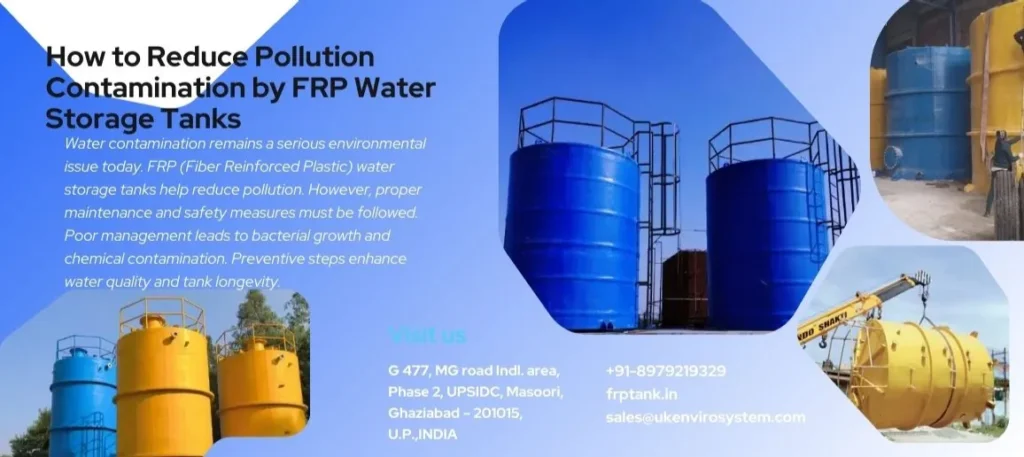
Water contamination remains a serious environmental issue today. FRP Water Storage Tanks help reduce pollution. However, proper maintenance and safety measures must be followed. Poor management leads to bacterial growth and chemical contamination. Preventive steps enhance water quality and tank longevity.
Choose High-Quality FRP Water Storage Tanks
The quality of FRP tanks directly impacts water purity. A well-manufactured tank prevents chemical leaching effectively. Reputed brands offer tanks with advanced protective coatings. These coatings reduce the risk of internal contamination. Always check certifications before purchasing an FRP tank.
Additionally, high-grade resins improve the tank’s durability. Non-toxic materials ensure safe water storage for consumption. Poor-quality tanks degrade quickly and release harmful substances. Moreover, reinforced structures minimize cracks and leaks significantly. Investing in superior FRP tanks prevents future contamination issues.
Ensure Proper Installation and Sealing
Proper installation minimizes the chances of external pollutants entering. Professional technicians should install FRP tanks carefully. Incorrect positioning may lead to water stagnation and bacteria. Moreover, airtight sealing reduces exposure to airborne contaminants.
Additionally, secure lids prevent dust and insects from entering. Gaps or loose fittings lead to leaks and pollution. A well-sealed tank maintains water purity for a longer time. Regularly inspecting the sealing points enhances overall safety. A protective environment ensures the water remains uncontaminated.
Conduct Regular Cleaning and Maintenance
Regular cleaning helps in reducing accumulated pollutants inside tanks. Over time, sediments and bacteria form layers on surfaces. Ignoring maintenance leads to severe contamination issues. A scheduled cleaning routine eliminates impurities effectively.
Additionally, safe cleaning agents should always be used. Harsh chemicals cause damage and increase pollution risks. Soft brushes help remove deposits without harming inner coatings. Rinsing with clean water ensures no residues remain. Experts recommend maintenance at least twice a year.
Use Advanced Filtration Systems
Filtration prevents pollutants from entering stored water. Advanced filtration methods improve the overall purity. Pre-filtration helps remove larger particles before storage. High-efficiency filters block dirt, bacteria, and harmful chemicals.
Moreover, UV filtration kills harmful microorganisms efficiently. Activated carbon filters remove organic pollutants and odors. Multi-stage filtration provides maximum protection from contamination. Installing a reliable filtration system enhances safety significantly. Proper maintenance of filters ensures optimal performance always.
Implement Proper Water Treatment Techniques
Water treatment reduces microbial and chemical contamination effectively. Disinfection techniques improve the quality of stored water. Chlorination remains a widely used treatment method today. However, excess chlorine levels must always be avoided.
Additionally, eco-friendly disinfectants provide safer alternatives. Ozonation removes bacteria without harmful byproducts. Advanced oxidation techniques ensure chemical-free purification. Water treatment enhances tank hygiene and storage conditions. Regular monitoring of disinfectant levels ensures proper balance.
Monitor Water Quality Consistently
Water quality testing prevents serious contamination risks. Real-time monitoring helps detect pollution at an early stage. Digital sensors measure turbidity, pH, and microbial levels. These tools provide instant contamination alerts effectively.
Additionally, laboratory testing ensures compliance with safety standards. Periodic sampling detects hidden contaminants in stored water. Poor-quality water affects health and plumbing systems. Consistent monitoring maintains optimal water conditions efficiently. Preventive measures reduce long-term contamination problems significantly.
Prevent External Contaminant Entry
Environmental exposure increases pollution risks inside storage tanks. Covered tanks protect water from airborne pollutants. Dust, insects, and algae growth are minimized effectively. A secure lid prevents debris accumulation and bacterial growth.
Moreover, proper ventilation prevents moisture buildup inside tanks. Excess humidity leads to mold and bacterial contamination. Vents with filters block harmful particles from entering. Ensuring a controlled storage environment reduces contamination risks. These measures improve water purity and storage safety.
Avoid Chemical Reactions Inside the Tank
Certain chemicals react with FRP tank materials over time. Corrosion causes harmful substances to leach into water. Non-corrosive coatings prevent these unwanted chemical reactions. Ensuring a chemically stable environment reduces pollution risks.
Additionally, monitoring pH levels prevents acidity-related reactions. Acidic water deteriorates tank linings quickly. Alkaline water may also cause unwanted residue buildup. A balanced pH maintains both tank integrity and water quality. These precautions prevent contamination due to material degradation.
Use Eco-Friendly Coatings and Liners
Protective coatings reduce the chances of internal pollution. Non-toxic liners prevent harmful substances from mixing with water. Additionally, specialized coatings resist bacterial and fungal growth. Using food-grade liners enhances safety and water purity.
Moreover, seamless coatings prevent cracks and leakage risks. FRP tanks with antimicrobial linings offer better protection. Investing in advanced protective layers minimizes contamination. Regular inspections ensure coatings remain intact and effective. Preventive measures enhance tank performance and longevity significantly.
Promote Sustainable Water Management Practices
Sustainable practices reduce pollution and contamination risks. Collecting rainwater in FRP tanks provides an eco-friendly solution. However, proper filtration must always be applied before storage. Untreated rainwater may contain harmful contaminants and bacteria.
Moreover, responsible water usage reduces unnecessary pollution. Overuse leads to stagnant water, increasing contamination risks. Proper drainage systems help maintain tank cleanliness effectively. Sustainable water management ensures long-term pollution control. These practices contribute to a healthier environment overall.
Conclusion
Reducing pollution contamination in FRP Tanks ensures clean water storage. Proper installation, maintenance, and filtration improve water quality. Monitoring and sustainable practices further enhance contamination control. Following these steps guarantees safe and eco-friendly water storage.
